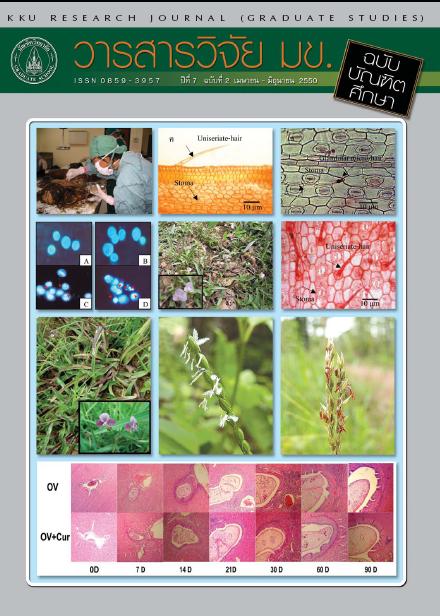Field-Cycled Proton-Electron Double-Resonance Imaging (FC-PEDRI) of a 14N nitroxide free radical at low magnetic field
Keywords:
FC-PEDRI, 14N Nitroxide free radical(อนุมูลอิสระ14N ไนตรอกไซด์), Low magnetic field(สนามแม่เหล็กความเข้มต่)Abstract
การสร้างภาพของอนุมูลอิสระ 14N ไนตรอกไซด์ได้ใช้เทคนิคการสั่นพ้องทางแม่เหล็กของอิเล็กตรอนและโปรตอนแบบลดสนามแม่เหล็กสำหรับอิเล็กตรอน (FC-PEDRI) โดยทำให้เกิดการแทรนซิชันชนิด ¶ แบบอิ่มตัวในปรากฏการณ์การสั่นพ้องทางแม่เหล็กของอิเล็กตรอน (EPR) ได้สร้างขดลวดที่ให้คลื่นวิทยุที่มีการโพลาไรเซชันแบบวงกลมสำหรับ EPR ทำการทดลองเพื่อหาตำแหน่งของการแทรนซิชัน EPR โดยใช้เทคนิคการโพลาไรซ์ทางนิวเคลียร์แบบไดแนมิกแบบลดสนามแม่เหล็กสำหรับอิเล็กตรอน (FC-DNP) กับสารละลายตัวอย่างทดลอง TEMPOL (ระบบ 14N ไนตรอกไซด์) ความเข้มข้น 1 และ 2 mM ที่ความถี่ EPR ในช่วง 45-133 MHz และได้ทำการทดลอง FC-PEDRI ที่สนามแม่เหล็กความเข้มต่ำ (0.3-6.2 mT) สำหรับ EPR โดยรับสัญญาณ NMR ที่สนาม 59 mT สำหรับการทดลองนี้ การแทรนซิชันชนิด ¶ เชิงบวกของ T45¶ มีความสำคัญและมีประโยชน์อย่างมาก เนื่องจากเป็นการแทรนซิชันที่ใช้สนามแม่เหล็กความเข้มต่ำและความถี่ต่ำ ซึ่งมีผลทำให้ลดการดูดกลืนกำลังของ EPR ในตัวอย่างทดลองได้ นอกจากนี้ พบว่าสัดส่วนของสัญญาณต่อสัญญาณรบกวน (SNR) ของภาพผลต่าง (ภาพจากที่มีการกระตุ้น EPR ลบกับภาพจากที่ไม่มีการกระตุ้น EPR) จากการกระตุ้นการแทรนซิชันชนิด ¶ เชิงลบที่ความถี่สูงกว่า (124-133 MHz) จะให้ค่า SNR มากกว่าเมื่อกระตุ้นที่ช่วงความถี่ที่ต่ำกว่า (45-113 MHz)Field-Cycled Proton-Electron Double-Resonance Imaging (FC-PEDRI) was used to image a 14N nitroxide free radical by saturation of π Electron Paramagnetic Resonance (EPR) transitions. A circularly-polarized EPR resonator was built for use with the FC-PEDRI experiments. To locate EPR π transitions, field-cycled dynamic nuclear polarization (FC- DNP) experiments were performed with 1 and 2 mM TEMPOL solution samples (a 14N nitroxide system) at EPR frequencies in the 45-133 MHz range. FC-PEDRI experiments were performed at low magnetic field (0.3-6.2 mT) for EPR with a proton NMR detection field of 59 mT. The positive π transition of T45π is useful in these experiments because the transition is at low magnetic field and low frequency, yielding a lower EPR power deposition in the sample. In addition, the signal-to-noise ratios (SNR) of the difference images (EPR-on minus EPR-off) from the saturation of negative π transitions in the higher frequency (124-133 MHz) were greater than those at lower frequency (45-113 MHz).



